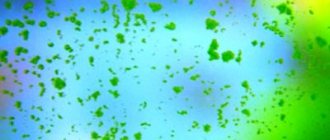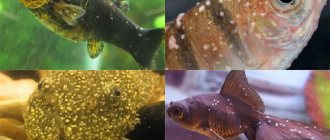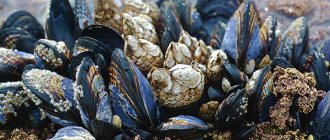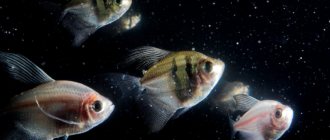- Wild animals
- >>
- Crustaceans
The giant spider crab is the largest known species and can live up to 100 years. The Japanese name for the species is taka-ashi-gani, which literally means “high-legged crab.” Its bumpy shell blends into the rocky ocean floor. To enhance the illusion, the spider crab decorates its shell with sponges and other animals. Although these creatures scare many with their spider-like appearance, they are still an amazing and fascinating wonder hidden in the deep ocean.
Description
Crabs, or short-tailed crayfish in other words, are a detachment from the subtype Crustaceans, included in the class Higher Crayfish. The remains have been discovered in fossils dating back to the Jurassic period. Now they have hardly changed their appearance and still look like their ancestors. These arthropods are located almost all over the globe.
Crabs are close relatives of crayfish. Their difference is in the external absence of the abdomen, which ends in the tail. They have an abdomen, but it is too small and is located under the chest. The tail would interfere with movement on land.
In these crustaceans, the body size depends on the specific species and ranges from 4 to 35 cm. A distinctive feature from other animals is the presence of strong claws, which are designed for hunting, protecting and cleansing the body. Another 4 pairs of limbs help arthropods move. Small, underdeveloped 2 limbs near the mouth opening help absorb food.
They live in rivers, seas, oceans, rarely on land. They are able to swim in the water column and crawl along the bottom.
The shell color of most species is brown-green. But the body color of different species adapts to their environment. The inhabitants of the sandy bottom are golden beige in color, while those who like to hide in algae are light green. Representatives from coral reefs are colorful.
Arthropods are becoming increasingly common aquarium pets. But they are not very friendly to other underwater inhabitants, even to members of their own family. It is better to keep them alone.
How long do they live?
The lifespan of crabs ranges from 3 to 6 years.
Interesting facts about crab spiders
In addition to the unusual method of transportation, the representatives of this family have several more interesting talents in their arsenal:
- in one day, spiders from this family can eat an amount of food whose weight exceeds the weight of their own body;
- due to the special structure of the limbs, side-walking spiders can move not only left and right, but also forward and backward;
- White side-walking spiders are capable of changing the color of their body from white to yellow, and back.
Types of aquarium crabs
For each type of aquarium crab, certain features of maintenance, feeding and reproduction are preferred. Therefore, when purchasing, be sure to pay attention to what type of crab you are buying.
Let's look at the most common types of crabs.
Red mangrove
The red mangrove species naturally lives in water bodies of the South Asian part. This is one of the types of crabs that live near sandy shores or in creeks with a sandy bottom. “Mangrove” got its name from its favorite place of residence - thickets of mangrove forests.
The color of the shell of this species ranges from burgundy to dark brown. The limbs are the same color as the shell, excluding the claws. The claws are painted a rich red color, becoming lighter towards the end. The size is small - it reaches only a few centimeters in length.
For one individual of the red mangrove species, you will need a small aquaterrarium measuring 35*35 cm and a water height of 10–15 cm. Land should make up at least 20% of the volume of the aquaterrarium. Prefers to live in slightly salted water. Not too sensitive to water hardness and acidity. When keeping several mangrove crabs, conflicts and skirmishes will arise between them.
The pet's place of residence must be covered with a lid. This is a necessary measure because the red mangrove species is distinguished by its agility. He will easily climb up rocks and logs and jump out.
Does not reproduce outside the natural environment.
Dutch
The Dutch species is found in Holland, the Caspian and Azov seas. This species is well suited for inexperienced crustacean keepers. They have no difficulties in maintenance. Their environmental requirements during molting are not too high. Lifespan under optimal conditions is 2.5 – 3 years.
The Dutch species is small in size. An adult specimen grows up to 3–4 cm in length. The carapace is painted in dark shades.
The Dutch crab is a freshwater species and is therefore kept in unsalted water in an aquarium. The look is not too aggressive. Because of this, they are able to live together with other fish. It is desirable that other inhabitants spend most of their time in the upper and middle layers of the water. This will help avoid conflicts. Shows aggression with other representatives and defends its territory.
It is destructive to plants. These short-tailed crayfish love to dig up roots and tear off lower leaves. Use artificial plants or plants with strong root systems.
They do not require special conditions for reproduction. The incubation period for eggs is one month. After this, the larvae hatch, which after a few days turn into small copies of their parents a few millimeters in size.
Dwarf
Its natural habitat is the backwaters of Thailand and neighboring countries. This species is considered the smallest among invertebrates. An adult representative reaches a size of 0.5–1.3 cm. Because of its size, it is called a spider crab, a micro-spider. Lives in fresh water bodies. Life expectancy is 1.5–2 years.
Dwarf representatives are not brightly colored. Their body is gray or light greenish. There are small hairs or fluffs on the body. With their help, water is filtered and food particles are searched for at the bottom.
Keeping a crab is not difficult. For a dwarf species, a container of 8–10 liters is suitable. Able to get along with other fish. But aggressive and predatory fish will prey on the small arthropod. In this case, it is better to organize a separate tank. They are active at night. The rest of the time they hide in shelters and plants.
For breeding, raise the temperature to 28–30 degrees. After mating, the larvae hatch within a month. Babies do not need special care.
Rainbow
The rainbow crab is the most popular pet among crustaceans due to its bright, colorful colors and easy care. Has other names: patriot, indigo, ground, tricolor. In its natural environment it lives on the shores of the Pacific Ocean.
The iridescent-looking shell is a deep blue or pale purple. The lower part of the body is light beige. The limbs are dark orange in color. The outer side of the claws is not colored or is poorly colored. The average size of adult representatives is 20 cm.
Rainbow representatives are capricious and demanding of care. They will need a spacious aquaterrarium with a large part of land. A minimum amount of water space is required. In their natural environment, the rainbow species is in the water only during molting and breeding, and spends the rest of its life on land.
It does not reproduce at home.
A vampire
The vampire crab attracts aquarists with its exotic appearance. The shell, limbs and head are painted a rich purple color. Orange eyes contrast against this background. Body size 1.5–3 cm. In nature, they live in fresh water bodies and rivers of India, Asia, on the islands of Java, Hawaii.
A terrarium or aquaterrarium with a volume of 30–40 liters is suitable for keeping several representatives. In their natural environment, they prefer to feed on the decaying lower part of sphagnum moss. At home, they feed on small insects and special food for crustaceans.
Good compatibility with other creatures; vampires do not show aggression or territoriality.
They do not tolerate acclimatization well. Sometimes vampires die while molting. This occurs due to a lack of vitamins and nutrients to rebuild the body.
Red Devil
In its natural environment it lives in southern Asia. Called the “red devil” because of its specific body color. The limbs, sides and muzzle are black. Against this background, the rich red claws, spots on the shell and head stand out in contrast.
In appearance, this crustacean really creates a repulsive impression. But this is a peaceful and non-aggressive species. Able to get along with peaceful fish. Body size 3–5 cm.
An aquaterrarium or paludarium is equipped with a small water part. The remaining part is allocated to land. Plant plants on it. Air humidity is 90–95%.
Malawian
The Malawian species received its name from the habitat where it was first found. They live in abundance in Lake Malawi, which is located in eastern Africa.
The main color of the shell and limbs is blue-blue. The lower part of the body is colored brown or burgundy. The size of the shell is 10–12 cm, and the length of the claws is 5–7 cm.
The Malawian species is aggressive and is capable of defending its territory in fights and capturing new ones. Therefore he is kept alone. Able to get along with Malawian fish, as in the natural environment.
This species is quite strong and is able to carry small stones and build slides from them. If the tank does not have a lid or mesh to protect it, the crab may escape.
These crustaceans require a minimum amount of animal proteins, because overfeeding will provoke excessive aggressiveness.
Ritropanopeus blacksea
Ritropanopeus Black Sea or otherwise Dutch crab was first discovered in the coastal regions of Holland. Later it was discovered that it also lives in the coastal parts of the Black Sea and Caspian Seas and even in the Don River.
Ritropanopeus is not large in size, its body size is about 4 cm. The body color is brownish-brown with small spots to hide in silt and bury itself in sand. The lower part of the body is much lighter.
Dutch crabs are recognized as unpretentious to the environment and quickly adapting pets. They have a calm temperament; conflicts arise only during the breeding season.
The Dutch will need a spacious aquaterrarium. With a lot of aquarium vegetation.
They reproduce well at home. The main factor for successful breeding is salt water, close in composition to sea water. In fresh or slightly salted water, the caviar will disappear.
Royal Leopard
The King Leopard or Panther Crab is a species found in freshwater bodies of Indonesia. Leopardov is named for its appearance. The main body color is light and beige. The entire body, except the bottom, is covered with dark small spots. Grows up to 12 cm.
The character of the King Crab is not very peaceful. In the presence of other creatures, it will selflessly defend its territory.
Leopard representatives do not need land, like some other species. They also live quietly in aquariums. Plant a sufficient number of plants edible for arthropods in the aquarium.
What do they eat?
They feed on plant matter and particles of animal remains, for which it is nicknamed an omnivorous scavenger. He is not a predator, does not hunt, but only collects decaying dead remains along the bottom. The crustacean feeds on small fish, carrion, various aquatic crustaceans, marine invertebrates, algae, macroalgae, and detritus. The crab is a spider by nature as a cleaner, so it carefully collects the remains of vegetation and living creatures. May eat live shellfish. Crab is caught for human consumption as it is considered a great delicacy in Japan and throughout the world. In life, the spider crab leads a calm lifestyle, wanders in search of food, and calmly moves among stones and potholes. Deprived of the opportunity to swim. His claws serve him as knives, with which he can tear apart necessary objects and attach them to his shell.
The crab regularly sheds its shell, which is replaced by a larger shell. The largest crab caught was 40 years old. How crabs interact with each other is not fully understood. It has been established that they lead a solitary lifestyle and have little contact with each other. Living in artificial conditions, in special aquariums, animals are isolated from any communication with their own kind.
Their sensory system is quite developed. Crabs living off the coast of Japan are called decorator crabs. They received this name for their love of collecting various objects and attaching them to their shells. This method helps them better camouflage and protect their existence.
Conditions
When keeping a crab in an aquarium, it is important to know the characteristics of their body, daily routine, and dietary preferences. Before purchasing an arthropod pet, you need to weigh the pros and cons, find out information about keeping and caring for them.
Water requirements
A large number of varieties of crustaceans live in salt water bodies. Therefore, the water in the aquaterrarium should also be salted. To do this, use sea salt. If it is not available, then mix table salt, soda and calcium chloride.
Crabs do not need very high water levels like fish. 10–15 cm will be enough.
Water must be purified from foreign impurities, especially nitrates and ammonia. The inhabitants of the aquarium quickly become poisoned by the products of their vital activity. The water needs to be changed frequently and regularly.
Water hardness does not affect the life of arthropods, but this indicator should be below 10. Water acidity is 7–8 pH. The water temperature should remain at the same level of 25–27 degrees, without sudden fluctuations.
Soil and plants
A soil base is essential in a pet's home. Bacteria multiply in the soil, useful for maintaining biobalance in the mini-ecosystem of the aquaterrarium. A good choice would be zeolite with the addition of crushed coral. Gravel and tuff granules are used as a replacement.
Their size should not be small; the correct size is 4–5 mm. This will facilitate the siphoning process, which is mandatory for crustacean soil.
Plants in an aquarium are planted not for decoration, but for food. Therefore, it is important to choose safe species of underwater plants. Plants that are aquatic or located in the water column are better suited. On rooted plants, crustaceans will dig up and damage the roots.
Suitable plants:
- Pemphigus.
- Duckweed.
- Java moss.
- Water hyacinth.
- Riccia floating.
- Vallisneria.
Requirements for an aquarium
The main requirement for an aquarium is a sufficient amount of dry land. A fatal mistake would be to add crabs to a tank without dry land; because of this, the arthropods usually die within the first month after purchase. On land, lay a small slide or a ladder of stones that your pet can climb up.
The dimensions of the aquaterrarium for one representative are 50*50 cm, for several - 1*1 m.
Home equipment
When setting up an aquarium, remember the characteristics of crabs. They are more suited not to an open body of water, but to moist soil or moss under their limbs and high air humidity. But the aquarium still has a small bathing area in which the pet can completely immerse itself. The bath is useful during molting or simply to wet the gills.
Avoid placing heating pads, filters, cleaners, or lamps with wires in the aquaterrarium. The arthropods will bite them with their claws and get electrocuted. Place all equipment out of reach.
To prevent burrowing, place a pipe inside that your pet can climb into.
Equipment
To monitor the temperature, you will need a thermometer. It is located on the wall or inside the aquaterrarium.
If the crab spends a long time in water, then install a filter and compressor in the pond. This will help purify the water and create small currents so that the water does not stagnate.
Freshwater
Freshwater crabs in an aquarium require settled fresh water with plenty of calcium carbonate. For an aquarium with fresh arthropods, the water temperature is maintained at 23 degrees. The water should not be too soft.
Nutrition
The giant spider crab is an omnivorous scavenger. The crustacean rarely hunts, collecting dead, decaying remains of marine life and plants on the ocean floor. The monster's hunting trophies are small, slow-moving oceanic invertebrates. With their claws they deftly open mollusk shells and love to feast on live algae.
Experienced sailors tell horror stories about how a Japanese spider crab dragged a man underwater from the deck and then feasted on his body. Most likely this is just a scary story, but probably the arthropod will not refuse to taste human dead flesh.
Reproduction
Preparations for the mating process occur after the winter molt at sea. The female is capable of laying up to several thousand eggs. She spawns eggs on the abdominal limbs, and the male fertilizes them. The incubation process lasts several months. The eggs hatch into tiny larvae that settle on nearby plants until they develop into small crabs. As they grow, they change their shell several times during molting.
Determination of gender
Males and females are distinguished by the shape of their underbelly. In females it is round and large, while in males it is wedge-shaped and elongated, smaller in size. Males are also larger than females in size and limb length.
Shedding
Young representatives quickly grow out of their shell and the molting process occurs. It is regulated by internal enzymes that form a new shell while still inside the old one. During molting, even the walls of the intestines and some internal organs are replaced, and the lining of the eyes is replaced.
The old shell breaks on the sides and on the abdomen, and the crab crawls out of it. This process takes no longer than half an hour. Their new shell is still soft and is not able to protect the animal. Therefore, they hide under stones and driftwood until their shell hardens.
Social structure
The crustacean reaches sexual maturity by 10 years. At the legislative level, there is a ban on catching spider crabs in the spring, as well as from the beginning of winter to April. During this period, animals actively mate, and the restriction makes it possible to maintain the population and increase the number. Mating occurs once a year, and the female can lay up to 1,000,000 eggs.
Fertilized eggs, which are attached to the abdominal appendages, hatch into small planktonic larvae. Their development interval lasts from 50 to 80 days. The larvae resemble plankton in appearance: small, transparent, drifting on the water surface. The development of larvae occurs in stages: at the larval stage they live in shallow depths, and as they grow up they go into deep waters.
Reviews
People speak positively about crabs. Owners are attracted by the beauty of the arthropod, so they don't need to take too much care of the crab. At home, it is better to keep them in a separate tank, because clashes and conflicts occur. Another disadvantage was the frequent replacement of water. But still, the owners are not ready to give up crabs and these disadvantages can be easily corrected.
Harm and benefits from side-walking spiders
The main harm that representatives of this family cause is the destruction of honey bees. Beneficial pollinators very often become victims of flower side-walking spiders. Thanks to its very good appetite, this small spider can kill and eat 2-4 bees in one day.
As for benefits, sidewalk spiders play a very important role in nature and control the number of harmful insects.
Crab Spider Venom
Sidewalker on a flower.
The venom of spiders of this family plays a serious role in medicine. Based on it, various drugs are being developed that help in the treatment of the following diseases:
- arrhythmia;
- Alzheimer's disease;
- erectile dysfunction;
- stroke.
Is a sidewalk spider bite dangerous for humans?
A crab spider bite does not pose a serious danger to a healthy adult, but can cause the following symptoms:
- weakness;
The crab spider is an excellent hunter.
- redness and swelling at the site of the bite;
- itching and burning;
- dizziness and headache.
It is worth considering that for allergy sufferers, people with weak immune systems and small children, the bite of a sidewalk spider can be very dangerous.
Prices
The cost of a crab depends on its age and type.
- The average price for young aquarium crabs is 150 rubles.
- Price for teenagers is 250 rubles.
- The cost of adult individuals ranges from 300 to 550 rubles.
Varieties of crabs. Each type of crab has its own price. It depends on the prevalence of the species, the ease of its care and cultivation and other factors.
- Dwarf crab costs 160–170 rubles.
- Mangrove - 370–400 rubles.
- Vampire crab - 530 rubles.
- Rainbow crab - 500 rubles.
- Royal leopard - 550 rubles.
Natural enemies
Despite its gigantic size and threatening appearance, the spider crab has many enemies. To ensure their safety, crustaceans live at great depths, where it is difficult to reach, and also camouflage their shells, decorating them with sponges or algae. Due to the spotted color and irregularities, the shell is similar to a stone or the ocean floor. Despite its massive size, the spider crab should beware of the octopus, which may attack it.
Octopus is the enemy of the spider crab
Animals are caught for housing in aquariums, for beauty and for food.
Adviсe
Some tips that will make caring for crustaceans easier and help create the necessary living conditions:
- Keep your pets alone or in pairs.
- Provide enough sushi.
- Keep the water clean.
- Provide high air humidity.
Before purchasing these arthropods, consider whether you can provide him with optimal care and care. In return, you will receive an exotic and unusual pet that will delight your eyes every day.
Materials taken from the source: rybkies.ru
Peculiarities
Sidewalk spiders do not spin webs to catch flying insects. Female spiders make sacs from this sticky substance into which they lay their eggs. They also use webs to descend from taller plants to lower ones. But the most amazing thing is that with the onset of autumn they use it as a means of transport. Having ridden the bags, they are able to go on a long journey with the first gust of wind. In warm and dry weather, they cover a distance of several kilometers. Sometimes you can see a whole family of spiders on one web. To stop at a place they like, they simply shoot a web onto the nearest tree or plant.
Hunter Tactics
Despite their size, spiders are not afraid to attack larger insects. Like real hunters, they can sit in ambush for a long time, waiting for prey with open paws. As soon as a butterfly or wasp lands on a flower, they instantly grab them and bite them in vulnerable places. Having injected the poison, the flower spider begins to eat. However, if a hunter has not eaten for a long time, then his behavior changes radically. He runs restlessly through the leaves, looking for prey and moving his paws in anticipation of lunch. At the sight of an approaching insect, the spider freezes with its legs wide open. From the outside it seems that he opened friendly arms. Thanks to their coloring, they manage to remain unnoticed, and the tactic brings the desired result.
Reproduction
In early June, the mating season begins for sidewalk spiders. Males, like real gentlemen, court the female. If she considers the candidate worthy, then mating occurs. After a short break, the procedure is repeated, and after a while the female attaches cocoons wrapped in a web to the back of the leaves. Although this species does not tend to live surrounded by relatives, there are cases when a whole family of spiders lives on one plant.
Nutrition
Side-walking spiders are predators; they are not afraid to attack even insects larger than themselves. Spiders wait for their prey for a long time, camouflaging themselves with the terrain (flowers, soil, bark). Side-walking spiders are very mobile and when the long-awaited profit appears, they quickly grab it with their feet and inject their paralyzing venom into the body of the victim. Then, after some time, all the nutrients are sucked out of it, leaving only one shell.











